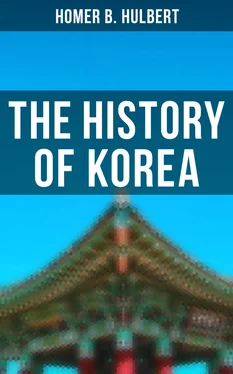Homer B. Hulbert - The History of Korea
Здесь есть возможность читать онлайн «Homer B. Hulbert - The History of Korea» — ознакомительный отрывок электронной книги совершенно бесплатно, а после прочтения отрывка купить полную версию. В некоторых случаях можно слушать аудио, скачать через торрент в формате fb2 и присутствует краткое содержание. ISBN: , Жанр: Прочая документальная литература, Исторические приключения, История, на английском языке. Описание произведения, (предисловие) а так же отзывы посетителей доступны на портале библиотеки ЛибКат.
- Название:The History of Korea
- Автор:
- Жанр:
- Год:неизвестен
- ISBN:4064066397135
- Рейтинг книги:3 / 5. Голосов: 1
-
Избранное:Добавить в избранное
- Отзывы:
-
Ваша оценка:
- 60
- 1
- 2
- 3
- 4
- 5
The History of Korea: краткое содержание, описание и аннотация
Предлагаем к чтению аннотацию, описание, краткое содержание или предисловие (зависит от того, что написал сам автор книги «The History of Korea»). Если вы не нашли необходимую информацию о книге — напишите в комментариях, мы постараемся отыскать её.
The History of Korea — читать онлайн ознакомительный отрывок
Ниже представлен текст книги, разбитый по страницам. Система сохранения места последней прочитанной страницы, позволяет с удобством читать онлайн бесплатно книгу «The History of Korea», без необходимости каждый раз заново искать на чём Вы остановились. Поставьте закладку, и сможете в любой момент перейти на страницу, на которой закончили чтение.
Интервал:
Закладка:
Meanwhile Prince Mun-ju had obtained help from Sil-la and with 10,000 troops was hastening homewards. He found the city in ashes, his father dead, the people mourning their lost, who had been dragged away captive. He promptly assumed control of affairs, moved the capital southward to Ung-jin the present Kong-ju, took all the Păk-je people away from Han-yang (Seoul) and moved them back across the Han River and abandoned all the territory beyond that natural barrier to Ko-gu-ryŭ to whom it had originally belonged. The following year he tried to send a message to the Sung Emperor by way of Ko-gu-ryŭ but the messenger was intercepted and the message stopped.
Chapter X
Quelpart … origin of T’am-na … new alliances … advances in Sil-la … but not in Păk-je nor Ko-gu-ryŭ … temporary peace. … Buddhism in Sil-la … remnants of barbarism … influence of Chinese literature … important reforms. … Ko-gu-ryŭ’s foreign relations … conquest of Dagelet Island … posthumous titles … colors in official grades. … Wei displeased … the “miracle” of Yi Cha-don … end of Ka-rak. … Sil-la rejects Chinese calendar … confusion in China. … Păk-je attempts reform … history of Sil-la … two alliances. … Păk-je and Ko-gu-ryŭ envoys to China … advance of Buddhism in Sil-la … music in Sil-la … war between Păk-je and Sil-la … retrogression in Sil-la because of Buddhism. … Ko-gu-ryŭ and the Sui Emperor … the Ondali .
Tradition says that in the dawn of history when the island of Che-ju (Quelpart) was covered only with a tangled forest three sages arose from a crevice in the ground. This spot is shown to this day by the people of Che-ju. These three men were Ko-ŭlla, Yang-ŭlla and Pu-ŭlla. As they stood upon the shore they saw three stout chests floating in from the south-east. Drawing them to land and opening them the three wise men discovered that each chest contained a calf, a colt, a dog,a pig and a woman, together with sundry seeds, such as beans, wheat, barley, millet and rice. By the three families thus organised the island was populated. During the early days of Sil-la a certain court astrologer announced that the “Friend Star” was visible in the south and that a distinguished visitor would soon arrive. Soon after this three men came by boat from Quelpart, landing at the harbor of T’am-jin, now Kang-jin. They came straight to the court of Sil-la where they were hospitably entertained. One of the visitors was Ko-hu, one was Ko-ch’ŭng, but thename of the third is lost. The king called the first Sŭng-ju or “Lord of the Star,” the second Wang-ja or “King’s Son” and the third To-nă or “The One who has Come.” He named their country T’am from the name of the port where they landed, and na , which seems to have meant “Kingdom”, for we find that the last syllable of Sil-la is this same na changed by euphonic laws to la . It is the root of the present Korean word na-ra or “kingdom.” So the kingdom was called T’am-na. The authorities are at a loss to tell the date or even the reign during which these events transpired. In the year 477 the little kingdom of T’am-na sent an envoy to the court of Păk-je with gifts. This is the first really authentic mention of the place. If tradition is of any value it must be confessed that the story of the peopling of Quelpart points toward a southern origin.
In 479 the aged king of Ko-gu-ryŭ, Kö-ryŭn, now in the sixty-eighth year of his reign, sought and obtained recognition from Emperor Ko-je (Kao-ti) the founder of the Ch’i dynasty in China. That this occurred in the very first year after the founding of that dynasty shows how sedulously Ko-gu-ryŭ was cultivating the good-will of the Chinese. Păk-je was not far behind, for she swore allegiance to the same Emperor only two years later.
During all these years it is to Sil-la that we must look for any signs of internal improvement, any of those innovations which are the mile-stones of progress. We saw above how she introduced the use of the cart and so raised a great burden from the shoulders of the people. The wheel is the great burden bearer of history. And now we find her introducing further reforms. The first was the horse relay system called the yong-ma . It did not bear so directly upon the condition of the people but it afforded an opportunity for the rapid transmission of official information and thus indirectly had an important bearing upon the welfareof the masses. In the next place, she organised a general market where at stated intervals merchants from the various districts could meet and exchange commodities. These are things that we look upon as matters of course and we do not realise their importance till we imagine ourselves deprived of the comforts that spring from the possibility of rapid communication and exchange of commodities. That Ko-gu-ryŭ had not made similar advances in the line of industrial reform is shown by the fact that when the Emperor of the Wei dynasty sent to grant investiture to Na-un the twenty-first king of Ko-gu-ryŭ in 499 he presented him with suits of clothes, flags, a crown and a cart. This shows that carts were not as yet in common use in Ko-gu-ryŭ. As for Păk-je, disaster was following upon disaster. At one time a thousand people were swept away in a flood. Then famine carried away three thousand. A few years later ten thousand people passed over into Sil-la to save themselves from starvation.
The sixth century dawned upon a comparatively peaceful Korea; for the time being the dogs of war were held in leash and feuds seem to have been laid on the shelf. The three kingdoms employed their time in different but characteristic ways. The king of Păk-je built an enormous pleasure-house and adorned it with all manner of curious flowers and animals. To the expostulations of his ministers he turned a deaf ear. A few years later he was murdered by one of his courtiers. In truth, peace was nearly as bad for Păk-je as war.
In Sil-la Buddhism had been introduced during the reign of Nul-ji, 417–458. A monk named Muk Ho-ja had been well received and was lodged in the palace. But, at the first, Buddhism did not find congenial soil in Sil-la. Tradition gives the following account of the first set-back which it suffered there. In 502 while the king was idling an hour away in a favorite summer-house outside the city, a raven appeared bearing in its beak a letter. It laid the missive at the king’s feet and flew away. The superscription said “If the king opens and reads this note two people will die; if he does not open it one will die”. He determined not to open it, but one of his attendants said, “The one referred to is Your Majesty and therefore you should open it even though two lives are sacrificed”. He broke the seal and read the strange words “Let the king take his trustiest bow, hasten to the palace and shoot an arrow through the zither case”. The king obeyed the mandate, hastened back to the palace by a private gate, entered the queen’s apartments unannounced and shot an arrow through a zither case that stood against the wall. The arrow pierced the zither case and the High Priest who was hidden behind it. The latter had taken advantage of the king’s absence to attack his honor. He was strangled together with the guilty queen.
With all her attempts at progress some evidences of the grossest barbarity still lingered in Sil-la. It was not, so the records tell us, until the year 503 that Sil-la discontinued the horrible custom of burying people alive when a king’s body was interred. It had been customary to bury five boys and five girls alive on such occasions, but in 503 the king published a decree forbidding the continuance of the custom. The very barbarity of the custom renders its abolition the more striking and places the name of king Chi-jeung, the twenty-second of his line, among the names of Korea’s benefactors. At the same time the custom of plowing with oxen was introduced, an innovation that had a most far-reaching effect upon society. It was in the beginning of the sixth century that Sil-la began to show evidences of the influence of Chinese literature and thought. In 504 she adopted the Chinese word Wang as the title of her kings in place of the pure Korean words I-sa-geum or Ma-rip-kan. She also changed the name of the kingdom from Kye-rim to Sil-la. We have been speaking of this kingdom under the name Sil-la but as a matter of fact it was not so designated until the year 504 A.D. Before that time it had been variously styled Sŭ-ya-bŭl, Sa-ro, and Kye-rim. The word Sil-la is said to have been composed of the Chinese words Sin and ra , which when united become Sil-la according to Korean laws of euphony. It is more than probable that it was merely an adaptation of Chinese characters to pure Korean words, for the last syllable la or na is the same as that used in other words, centuries before that time, in southern Korea. The na of T’am-na is the same character. To the word Sil-la was added the word Kuk or “kingdom” which put her in line with the other vassals of China. The Confucian code must have been making headway too, for in the following year the custom was adopted of assuming a mourning garb for three years upon the death of a parent. It was at this time that the influence of China upon Korea began to bear its legitimate fruit. Chinese religion, literature, government and art were beginning to mould the thought and life of the Korean people. Many Chinese words had been introduced into Korea before this time but the use of the Chinese character had not been general.
Читать дальшеИнтервал:
Закладка:
Похожие книги на «The History of Korea»
Представляем Вашему вниманию похожие книги на «The History of Korea» списком для выбора. Мы отобрали схожую по названию и смыслу литературу в надежде предоставить читателям больше вариантов отыскать новые, интересные, ещё непрочитанные произведения.
Обсуждение, отзывы о книге «The History of Korea» и просто собственные мнения читателей. Оставьте ваши комментарии, напишите, что Вы думаете о произведении, его смысле или главных героях. Укажите что конкретно понравилось, а что нет, и почему Вы так считаете.









